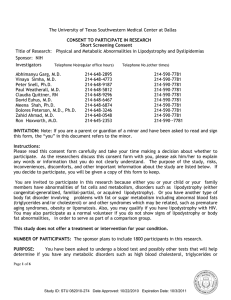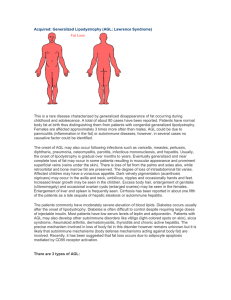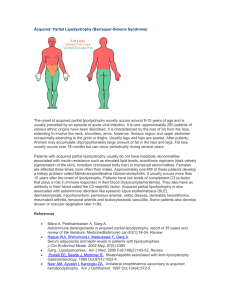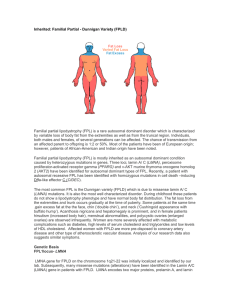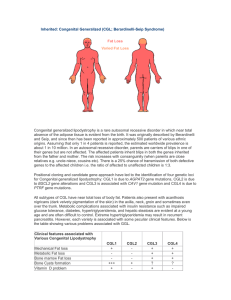Self Study Unit 3
advertisement
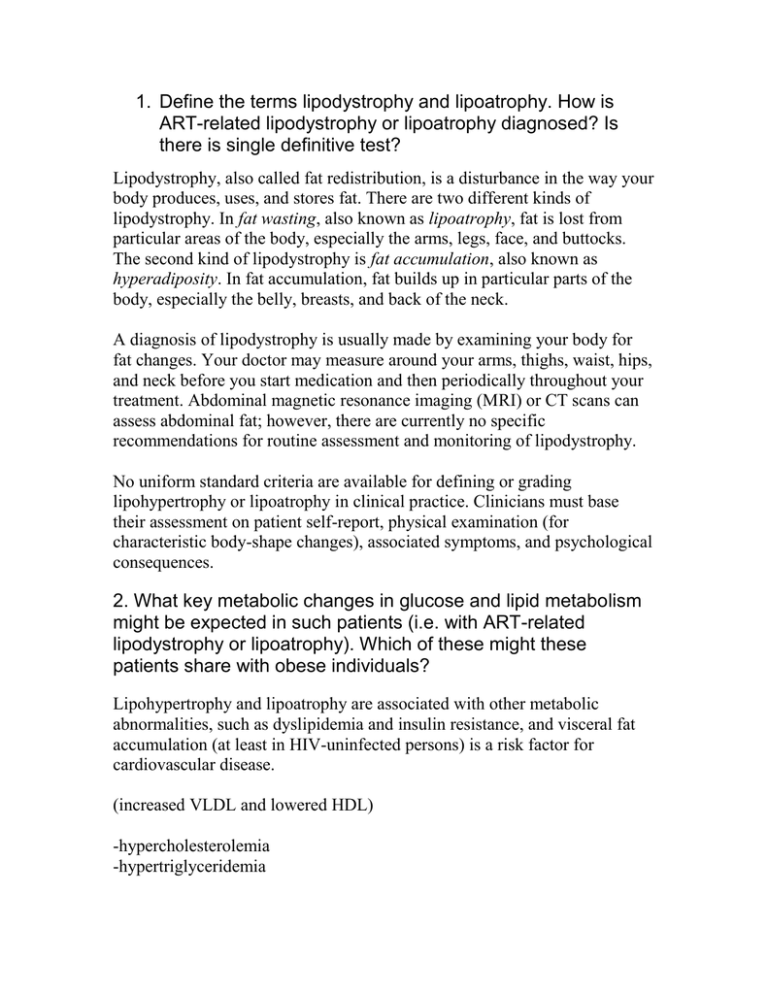
1. Define the terms lipodystrophy and lipoatrophy. How is ART-related lipodystrophy or lipoatrophy diagnosed? Is there is single definitive test? Lipodystrophy, also called fat redistribution, is a disturbance in the way your body produces, uses, and stores fat. There are two different kinds of lipodystrophy. In fat wasting, also known as lipoatrophy, fat is lost from particular areas of the body, especially the arms, legs, face, and buttocks. The second kind of lipodystrophy is fat accumulation, also known as hyperadiposity. In fat accumulation, fat builds up in particular parts of the body, especially the belly, breasts, and back of the neck. A diagnosis of lipodystrophy is usually made by examining your body for fat changes. Your doctor may measure around your arms, thighs, waist, hips, and neck before you start medication and then periodically throughout your treatment. Abdominal magnetic resonance imaging (MRI) or CT scans can assess abdominal fat; however, there are currently no specific recommendations for routine assessment and monitoring of lipodystrophy. No uniform standard criteria are available for defining or grading lipohypertrophy or lipoatrophy in clinical practice. Clinicians must base their assessment on patient self-report, physical examination (for characteristic body-shape changes), associated symptoms, and psychological consequences. 2. What key metabolic changes in glucose and lipid metabolism might be expected in such patients (i.e. with ART-related lipodystrophy or lipoatrophy). Which of these might these patients share with obese individuals? Lipohypertrophy and lipoatrophy are associated with other metabolic abnormalities, such as dyslipidemia and insulin resistance, and visceral fat accumulation (at least in HIV-uninfected persons) is a risk factor for cardiovascular disease. (increased VLDL and lowered HDL) -hypercholesterolemia -hypertriglyceridemia 3. Describe the role of the below two classes of anti-retroviral therapy (ART) drugs in the clinical manifestation of HIVassociated lipodystrophy and lipoatrophy. PIs and NRTIs, the two major classes of antiretrovirals associated with lipodystrophy in HIV-infected patients, may interfere at several steps of PPARγ signaling in adipose cells, such as differentiation, insulin action, oxidative stress, inflammation, and mitochondrial function. A) NRTI: -Altered adipocyte lipid phenotype and insulin sensitivity resulting from NRTI treatment are suspected to result from their mitochondrial toxicity. -Protease inhibitors may also reduce pancreatic beta-cell insulin secretion,53 but insulin resistance is the primary defect. Direct effects of nucleoside analogues on glucose metabolism have not been demonstrated, but such drugs may contribute to insulin resistance indirectly through changes in fat distribution. -In murine adipose cell lines and primary cultured human adipocytes, stavudine and zidovudine, but not other NRTIs (tenofovir, abacavir, didanosine, and lamivudine), alter lipid storage [23, 31, 33, 81]. They also decrease the expression and secretion of adiponectin in cultured human and murine adipocytes [23, 32, 33, 82] and induce oxidative stress, suggesting that they could secondarily participate to the insulin resistance setup B) PI: Protease inhibitors -may induce lipoatrophy by inhibiting sterol regulatory enhancer– binding protein 1 (SREBP1)–mediated activation of the heterodimer consisting of adipocyte retinoid X receptor and peroxisome proliferator–activated receptor γ (PPARγ) or related transcription factors such as PPARγ coactivator 1.13,14 In vitro studies have demonstrated that protease inhibitors can inhibit lipogenesis and adipocyte differentiation,15 stimulate lipolysis,16 and impair SREBP1 nuclear localization.17 -Most PIs (nelfinavir, indinavir, saquinavir, ritonavir, and amprenavir) were shown to acutely inhibit insulin activation of glucose uptake in cultured adipocytes, via a direct inhibition of the glucose transporter Glut4. -Individual protease inhibitors, most notably ritonavir, can increase hepatic triglyceride synthesis and plasma triglyceride levels -Protease inhibitors also tend to increase total cholesterol levels, but this effect also varies among the individual drugs in this class -Endothelial dysfunction and reduced flow-mediated dilation in association with increased atherogenic lipoproteins have been reported among HIV-infected adults receiving protease inhibitors 4. How would patients with ART or HIV-related lipodystrophy or lipoatrophy be treated or managed? What is the mode of action of the drug Tesamorelin? -Diet, lifestyle modification, and use of lipid-lowering and insulin-sensitizing regimens, and growth hormone may be useful in specific situations. Monitoring of fat around body and the prescreening for family history of dislipidemias before treatment begins are important. -Tesamorelin, also known as TH9507, is a type of medicine called a growth hormone-releasing factor (GHRF). GHRF causes growth hormone to be created and spread in the body, which helps control metabolism, body shape, and use of energy. 5. What type of abnormal cells/tissues comprise the “buffalo hump” found in HIV-infected patients on ART? - Fat accumulation may also be found within the breasts and over the dorsocervical spine (resulting in a “buffalo hump”)


